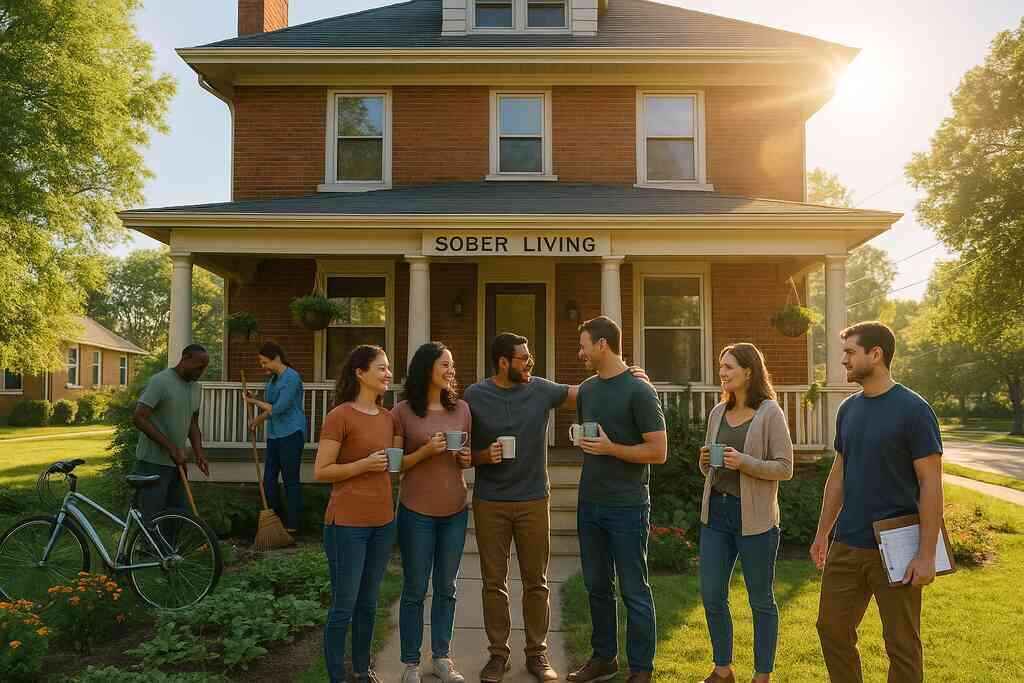
What Are the Core Principles of Top Sober House in Ohio
November 28, 2025
Launching the Journey Toward Ohio Sobriety
Why Top Sober House Ohio Sets the Gold Standard
Top Sober House Ohio consistently rises above other sober living houses by weaving evidence-based methods with genuine Midwestern hospitality. Residents quickly see that every policy, schedule, and amenity reinforces the top sober house Ohio principles of safety, accountability, and growth. Individuals searching for reliable Sober living options in Ohio can easily discover that this program pairs compassionate staff with strict standards, creating a uniquely balanced setting. Each newcomer is welcomed yet held to clear expectations, preventing confusion and nurturing personal agency from day one. That healthy tension between support and structure establishes a gold standard many recovery professionals now emulate statewide.
The program’s foundation rests on three pillars: abstinence-based housing, structured daily rhythm, and community reintegration. These pillars interact like gears, ensuring no resident slips through operational gaps often found in less organized group homes. Staff members highlight the importance of early recovery stabilization, explaining how house rules deter chaos while encouraging self-direction. Weekly feedback groups allow residents to voice concerns, making policy adherence feel collaborative rather than punitive. Because clients help refine guidelines, they form deeper buy-in and pride, fueling motivation to maintain long-term sobriety.
Translating Hope Into an Actionable Recovery Blueprint
Most individuals arrive carrying equal parts fear and optimism, uncertain how to convert intention into measurable progress. Top sober homes’ philosophy tackles that challenge by delivering a step-by-step blueprint that clarifies duties, milestones, and available resources. A resident’s first week involves crafting a personalized plan that links therapeutic goals to daily responsibilities, an approach modeled after best practices featured in the Find sober living homes near you directory. This living document evolves with input from mentors, counselors, and peers, ensuring alignment with the changing needs of individuals throughout early recovery. By externalizing goals, residents avoid vague promises and instead track tangible achievements that build recovery capital.
Equally crucial is the integration of relapse-prevention education with life-skills coaching. Interactive workshops cover budgeting, nutrition, and emotional regulation, thus bridging clinical insights with everyday tasks. Participants rehearse high-risk scenarios and practice assertive communication until responses feel second nature. The curriculum, updated quarterly, reflects Ohio’s evolving treatment landscape and new research on substance use disorder management. Graduates frequently report that knowing precisely what to do next made the difference between fleeting sobriety and durable change.
The Intersection of Early Recovery Needs and Safe Environment Realities
Early recovery resembles learning to walk on ice; every misstep threatens to send progress crashing to a halt. Therefore, a relentlessly safe environment becomes non-negotiable for residents of sober living homes statewide. Case managers at Top Sober House vigilantly monitor household dynamics, quickly addressing boundary violations or emotional triggers. The facility’s commitment to trauma-informed care ensures reactions are supportive yet firm, meeting residents where they are without compromising house integrity. Insights from the Pioneering sober success in Ohio article reveal that this balance drastically reduces early relapse rates.
Safety also extends beyond physical space into digital and social realms. Residents receive guidance on managing social media, establishing curfews, and vetting invitations that could jeopardize sobriety. House managers encourage attendance at local support groups, linking newcomers with seasoned peers who demonstrate a recovery lifestyle in real time. Regular neighborhood engagement projects show nearby communities the program’s positive impact, strengthening external support networks. When combined, these strategies transform a simple dwelling into a protective cocoon where early sobriety can truly flourish.
Abstinence Based Housing Model Anchored in Safety
Strict Substance Free Grounds and Random Drug Screening Policy
Substance-free grounds begin with a meticulous intake search that removes every potential trigger, including cologne with alcohol content. After orientation, residents sign cooperative living contracts that reaffirm their commitment to the safe, substance-free environment. Management then implements randomized urine, breath, and oral screenings, performed at unpredictable hours, to deter complacency. Results feed directly into each recovery journey plan, allowing swift clinical adjustments when necessary. Residents appreciate that transparency, replying that clear boundaries feel liberating rather than punitive. Many compare and note that these measures surpass other sober living options in Ohio that still depend on self-reporting.
Randomization algorithms ensure every resident faces equal screening probability, removing any perception of favoritism. Positive results trigger immediate safety protocols discussed later, while negative tests earn verbal reinforcement to strengthen motivation. The house manager records outcomes in secure digital logs, maintaining HIPAA compliance and preserving resident dignity. Weekly town-hall meetings analyze aggregate data without revealing individual names, proving that accountability can coexist with respect. This iterative feedback loop keeps the abstinence-based housing model both flexible and uncompromising.
Relapse Prevention Protocols and Immediate Response Procedures
Even with strict screenings, early recovery remains fragile, so Top Sober House installs layered relapse-prevention barriers. The first layer involves peer support governance, where residents observe behavioral shifts and discreetly alert staff. If warning signs appear, mentors conduct motivational interviews aimed at realigning the individual with house rules. Simultaneously, staff offer expedited counseling referrals and clinical check-ins to tighten external support systems. When higher care is required, residents receive escorted transfers to centers listed on the professional addiction treatment services info portal.
In the rare event of substance use on property, the immediate response prioritizes both safety and dignity. Staff isolate the situation calmly, removing paraphernalia and guiding other residents to communal areas. An on-call clinician performs an assessment to determine medical risk and necessary detox placement. Meanwhile, leadership reviews surveillance logs to verify events, ensuring transparent documentation for state compliance. This decisive, humane approach exemplifies evidence-based recovery practices that elevate Top Sober House above ordinary group homes.
House Rules Enforcement Without Compromise
House rules serve as the program’s social contract, defining limits around curfew, guests, chores, and mutual respect. New residents review each clause with a mentor, who contextualizes its purpose within the framework of recovery capital development. Violations trigger a graduated consequence ladder that begins with reflection assignments and can escalate to temporary suspension. Importantly, every sanction pairs with a learning component, turning missteps into teachable moments. Detailed discussions of this peer-led framework appear in the Ohio peer support role analysis published earlier this year.
House managers remain impartial referees, applying rules uniformly regardless of tenure or popularity. That fairness cultivates psychological safety, prompting residents to self-report lapses before they spiral. Weekly accountability circles allow peers to discuss minor infractions and negotiate restorative actions collaboratively. The culture mirrors successful 12-step traditions, though it retains secular flexibility for diverse spiritual viewpoints. Residents leave understanding that genuine freedom thrives only within clearly communicated boundaries.
Integration With Ohio Outpatient Program Linkages
Sobriety seldom progresses in isolation, so Top Sober House builds bridges to reputable outpatient programs across the state. Case managers schedule initial intakes within the first week, ensuring therapy continuity after residential treatment. Transportation coordination removes logistical excuses, giving residents one less barrier to consistent attendance. Program staff and outpatient clinicians share progress notes through encrypted platforms, maintaining HIPAA compliance. A detailed directory of these partnerships lives on the Top Sober House home platform, updated quarterly with quality metrics.
This integration strategy prevents the treatment cliff that many experience after leaving inpatient settings. Residents attend therapy, return to a sober environment, and immediately apply the coping skills they have learned during evening routines. Feedback flows in both directions, allowing counselors to highlight situational triggers observed within group homes. Simultaneously, house managers spot therapeutic breakthroughs and adjust responsibilities to reinforce new strengths. That constant loop embodies evidence-based recovery practices rooted in collaboration, not siloed treatment.
Continuum From Residential Treatment Center to Sober House Near You
Transitioning from a residential treatment center into sober housing marks a pivotal handoff, not a finish line. Top Sober House eases this move with pre-discharge meetings involving therapists, families, and future housemates. Collaborative planning clarifies medication schedules, trauma triggers, and employment goals before the resident arrives. Upon entry, the individual encounters familiar therapeutic language rather than starting over. An in-depth roadmap appears in the long term sobriety paths in Ohio guide, illustrating each milestone across the continuum.
The continuum model also anticipates future steps beyond sober living houses, such as independent apartments or collegiate recovery dorms. Exit planning begins at intake, embedding long-term sobriety pathways into daily routine recovery tasks. Residents gradually earn weekend passes, practice budgeting, and workshop job interviews before full graduation. Alumni remain connected through mentorship rosters and quarterly check-ins, which help reduce isolation during the early stages of independence. That alumni network circles back, guiding the next cohort and keeping the recovery community self-sustaining.

Structured Daily Rhythm and Recovery Capital Development
Mandatory 12 Step Meetings and Peer Support Governance
Residents at Top Sober House Ohio follow a structured daily routine recovery plan that starts with sunrise reflections. Mandatory 12-step meetings anchor every morning, giving residents a predictable rhythm and shared language of hope. Peer support governance oversees attendance, ensuring no one feels invisible or left behind. Because residents rotate leadership roles, accountability agreements become lived experiences rather than paperwork. That cooperative structure deepens recovery capital development from the very first week.
Afternoon check-ins reinforce the morning insights. Small groups dissect personal victories and stumbling blocks using clear, supportive feedback. The process mirrors business scrum meetings, yet the focus is on emotional growth. Participants leave with concise action items for the next twenty-four hours. Over time, this micro-goal strategy trains the brain to chase progress instead of perfection.
Employment Readiness Coaching and Life Skills Workshops
Early recovery demands practical victories, so employment readiness coaching begins immediately. Certified career specialists guide residents through résumé building, interview drills, and workplace ethics. Life-skills training program modules cover budgeting, digital literacy, and conflict management to elevate everyday competence. By rehearsing real scenarios, individuals replace anxiety with tested responses. Graduates report landing stable jobs faster than peers in less structured sober homes.
Evening workshops simulate common employment stressors, such as sudden deadlines or critical feedback. Role-playing allows residents to practice emotional regulation without real-world consequences. Trainers integrate evidence-based recovery practices, linking workplace resilience to sustained abstinence. Successful completion earns progressive curfew extensions, reinforcing the connection between responsibility and freedom. This tangible reward system keeps motivation high during demanding job hunts.
Trauma Informed Sober Care and Holistic Wellness Practices
Top sober houses in Ohio recognize that substance use disorder often hides untreated trauma. Therefore, every staff member receives trauma-informed sober care training before supervising a single shift. Gentle language, consent-based touch, and predictable schedules help residents feel secure and at ease. Yoga, expressive arts, and mindful breathing sessions round out holistic wellness practices. When the body and mind relax, deeper therapeutic work becomes possible.
Nutrition also plays a starring role in healing. A registered dietitian teaches residents how balanced meals stabilize mood and energy. Group cooking nights transform kitchens into laboratories of healthy experimentation. The result is a supportive sober living environment where residents learn to feed both body and spirit. These skills travel with them long after house graduation.
Collaborative Daily Routine That Builds Long Term Sobriety
Every element of the schedule interlocks like gears, forming a collaborative daily routine that counters chaos. Morning chores teach punctuality, while nightly gratitude circles reinforce emotional intelligence. House managers verify task completion but allow peers to mediate minor disputes first. This design strengthens resident accountability agreements without heavy-handed oversight.
Furthermore, weekly strategic planning sessions reference the redefining recovery paths in Ohio feature to track measurable goals. Residents visualize progress on shared whiteboards, celebrating milestones collectively. These micro-celebrations generate momentum toward long-term sobriety pathways. By practicing decision-making in a safe place, individuals gain confidence to navigate outside stressors. Over months, the routine shapes habits that endure beyond the house walls.
Accountability Culture and Community Reintegration
Resident Accountability Agreements and Cooperative Living Contracts
Accountability is the heartbeat of every Top Sober House Ohio residence. Upon arrival, residents sign cooperative living contracts that outline duties, curfews, and behavioral expectations. These contracts transform abstract ideals into concrete daily promises, reducing ambiguity during early recovery. Clear expectations encourage self-governance and deter the rationalization patterns common in alcohol addiction. Peers hold one another responsible, reinforcing the supportive sober living environment without constant staff intervention.
Every contract references the core principles of Top Sober House, aligning personal goals with house standards. Weekly check-ins review progress and allow amendments when clinical guidance changes. This collaborative update process nurtures resident accountability agreements rather than imposing unilateral mandates. Such practice distinguishes structured sober homes from looser arrangements sometimes mislabeled recovery housing. For newcomers unsure what shared living entails, reading the definition of a sober living house offers valuable context.
House Manager Oversight and Evidence Based Recovery Practices
Accountability thrives under vigilant, respectful oversight from trained house managers. Managers conduct daily walk-throughs to verify chores, medication compliance, and curfew adherence. Their presence discourages rule bending while modeling calm, solution-focused communication. Residents learn to view oversight as mentorship, not surveillance, strengthening trust in the sober living program. Immediate response procedures activate when someone veers off plan, preventing small slips from becoming relapses.
Evidence-based recovery practices guide every managerial decision inside these sober homes. Managers reference the addiction as a chronic disease context to explain why consistency, not punishment, sustains change. They document incidents using objective metrics, enabling data-driven improvements across all Top Sober House locations. Regular professional supervision ensures methods remain aligned with national treatment program standards. This cycle of measurement and refinement keeps Ohio halfway house standards moving toward continual excellence.
Peer Mentorship Networks and Alumni Support Across Ohio
Peer mentorship networks operate like lifelines within Top Sober House Ohio. Seasoned residents adopt newcomers, demonstrating day-to-day application of recovery skills. Mentors help interpret house rules, navigate cravings, and celebrate milestones without the use of substances. Shared lived experience breeds credibility that professional staff alone cannot replicate. The resulting camaraderie fuels structured daily routine recovery and strengthens community resilience.
Alumni extend this network beyond the house walls, offering job leads, housing tips, and social invitations. Quarterly statewide gatherings unite graduates from multiple top sober houses in Ohio. These events showcase long-term sobriety pathways and normalize ongoing support seeking. Because alumni once lived in the program, their stories verify its effectiveness to current residents. Cross-state partnerships, including supportive sober homes in Michigan, expand networking opportunities further.
Safe Place to Practice Conflict Resolution and Communication
Conflict inevitably surfaces when diverse personalities share a household. Top Sober House frames disagreements as training grounds rather than crises. Residents attend weekly workshops on assertive dialogue and emotional regulation. Role-plays allow practice in a safe place before applying skills at work or school. Successful resolution boosts confidence and reinforces a safe environment for everyone.
Facilitators integrate principles from the twelve step program explanation to guide humility and amends. Participants learn that admitting mistakes promptly prevents resentments that could threaten sobriety. House managers observe sessions and provide real-time feedback on tone, posture, and word choice. Over time, communication becomes less reactive and more solution oriented. These interpersonal victories directly translate into a reduced relapse risk during community reintegration.
Community Service Requirements That Strengthen Recovery Identity
Giving back anchors recovery identity in purpose beyond personal gain. Top sober homes philosophy mandates community service for every resident. Projects range from neighborhood clean-ups to mentoring teens about drug abuse prevention. Engagement counters stigma and showcases what successful sober housing can contribute to the local community. Residents log hours, reflecting on how service solidifies gratitude and humility.
Community partners often become employment references, thereby supporting long-term sobriety pathways. The service also introduces residents to sober social networks outside traditional support groups. These fresh connections broaden recovery capital development and lessen isolation. Feedback circles after each project encourage insight into teamwork strengths and growth areas. By consistently helping others, individuals rewrite personal narratives previously dominated by alcohol abuse.
Linkage to Support Groups and Halfway Houses for Extended Care
Sustained recovery often requires multiple levels of care over time. Case managers therefore map individualized pathways that include outpatient therapy, sober housing, and halfway houses. For residents relocating near family, referrals extend to quality programs like halfway houses in Pennsylvania. Such coordination prevents care gaps that frequently trigger relapse during transitions. Residents appreciate knowing support remains available wherever life leads next.
Top Sober House also connects individuals with external 12-step and peer support meetings. Using the find AA meetings near Ohio locator, residents schedule sessions that fit work demands. Those preferring non-alcohol specific groups receive links to NA or SMART Recovery alternatives. House managers verify attendance, yet empower residents to choose the most resonant fellowship. Consistent engagement in outside support circles cements skills practiced inside the Ohio sober living environment.

Empowered Futures and Continuous Growth
Building Recovery Momentum Beyond Sober Living Houses
Residents who master the core principles of Top Sober House soon crave fresh challenges that test their new skills. Continuing momentum means exporting the structured daily routine recovery strategies into wider life domains. Graduates schedule morning reflections, maintain chore charts, and attend evening check-ins even after leaving the sober living environment. This continuity preserves early recovery stabilization and prevents the drift that often precedes relapse. Because habits formed at top sober houses in Ohio emphasize accountability, outside responsibilities feel familiar rather than overwhelming.
Equally important is nurturing peer support wherever residents relocate. Alumni lean on virtual accountability circles, mirroring the house’s peer support governance model. These circles review weekly goals, celebrate small victories, and troubleshoot emerging stressors. Community reintegration planning also includes volunteer work, echoing service projects completed during residency. By coupling responsibility with purpose, individuals continue to accumulate recovery capital and strengthen long-term sobriety pathways.
Graduation Planning and Relapse Risk Mitigation
Formal graduation begins months before move-out, reinforcing the abstinence-based housing model’s focus on preparedness. House managers guide residents through detailed relapse prevention protocols that identify personal triggers and coping sequences. Plans include outpatient program linkage, primary care coordination, and crisis contacts. Residents also update employment readiness coaching materials, ensuring financial stability during transition. The goal is a safeguard network that activates automatically when stress spikes.
Mentors introduce the ultimate alcohol recovery in Ohio guide as an external compass for post-house challenges. This resource reviews statewide treatment programs, local support groups, and housing grants that reinforce sobriety. Integrating the guide with resident accountability agreements turns theory into actionable steps. Graduates exit with calendars marked for weekly meetings, therapy sessions, and exercise blocks, thereby limiting idle time. Data show that this tightly woven schedule cuts relapse odds dramatically during the first independent year.
Top Sober House Ohio as a Lifelong Resource and Ally
Graduation never severs ties with the supportive sober living environment that launched change. Alumni join a statewide alumni support network that Ohio residents can access for job leads, sober social events, and mentorship opportunities. Monthly webinars feature experts discussing career growth, nutrition, and evolving treatment program science. Participants submit questions live, preserving the two-way learning culture that defines Top Sober House Ohio principles.
The organization also maintains reciprocal relationships with sober housing partners nationwide. Graduates moving for work can locate a sober house near them through the same directory that guided their original placement. Whether someone heads to new employment in Cincinnati or explores Sober residences in the Indiana region, they still feel connected. Continuous outreach, data-driven newsletters, and invitation-only retreats remind alumni that support never expires. This enduring alliance exemplifies the top sober homes’ philosophy: recovery is not a finish line; it is a collaborative, evolving journey.
Frequently Asked Questions
Question: How does the abstinence-based housing model at Top Sober House in Ohio keep residents safe from relapse?
Answer: Safety starts the moment a new resident walks through the door. Staff complete a meticulous intake search to remove all alcohol- or drug-related triggers, then each person signs a cooperative living contract that reaffirms a zero-tolerance stance. Random drug screening policies-urine, breath and oral-run on an algorithm that gives every resident the same unpredictable chance of being tested, eliminating favoritism and complacency. If a test is positive, relapse prevention protocols activate immediately: the individual is assessed by an on-call clinician, linked to a higher level of care if needed, and the rest of the house is briefed to maintain transparency without shaming. By weaving strict rules with compassionate trauma-informed sober care, Top Sober House creates the safe substance-free environment essential for early recovery stabilization and long-term sobriety pathways.
Question: What specific relapse prevention procedures set Top Sober House apart from typical Ohio halfway house standards?
Answer: Top Sober House layers protection in three tiers. First, peer support governance empowers residents to spot behavioral changes early and alert house managers before a slip turns into a relapse. Second, evidence-based recovery practices such as motivational interviewing and cognitive-behavioral check-ins are offered on the spot, often within hours of a concern. Third, an established outpatient program linkage network across Ohio guarantees same-week therapy appointments or medical detox placement when higher care is required. Because these steps are built into written resident accountability agreements, everyone understands the plan long before a crisis occurs-something many traditional halfway houses simply do not offer.
Question: In the blog titled What Are the Core Principles of Top Sober House in Ohio, you mention a structured daily routine recovery plan; what does a typical day look like for residents?
Answer: The day begins with sunrise reflections followed by a mandatory 12-step or comparable support-group meeting that anchors each resident in purpose. Mid-morning, residents attend life-skills training program workshops covering budgeting, nutrition or employment readiness coaching. Afternoons focus on outpatient therapy sessions or job searches, supported by peer mentors and house manager oversight. Evenings feature group dinners, holistic wellness practices like yoga, and gratitude circles that reinforce recovery capital development. Curfew and quiet hours protect rest, and random drug screens can occur at any point. This rhythm blends accountability with growth, transforming a simple group home into a supportive sober living environment where healthy habits become second nature.
Question: How do resident accountability agreements and peer support governance create a truly supportive sober living environment?
Answer: Accountability agreements spell out daily chores, curfew, guest policies and conflict-resolution steps, removing the ambiguity that often undermines early recovery. Because residents help craft and periodically revise these agreements, they feel a sense of ownership rather than coercion. Peer support governance adds another layer: seasoned residents mentor newcomers, verify 12-step meeting attendance, and mediate minor disputes before staff intervention is needed. This model not only builds trust but also mirrors real-world responsibility, preparing residents for seamless community reintegration after graduation.
Question: Why should families trust Top Sober House when searching for a sober house near you that promotes lasting recovery?
Answer: Top Sober House operates a nationwide directory, but its Ohio locations showcase the gold standard. Every policy-from random drug screening to trauma-informed staff training-is rooted in evidence-based recovery practices vetted by licensed professionals. The organization partners with accredited outpatient programs, maintains a robust alumni support network that Ohio graduates can access for life, and publishes transparent results that demonstrate reduced relapse rates. Families also appreciate the holistic approach: residents learn employment skills, community service, nutrition, and mindfulness, ensuring they emerge not just substance-free but fully equipped for independent living. In short, Top Sober House combines Midwestern hospitality with uncompromising safety protocols to give loved ones peace of mind and residents the best possible chance at long-term sobriety.


